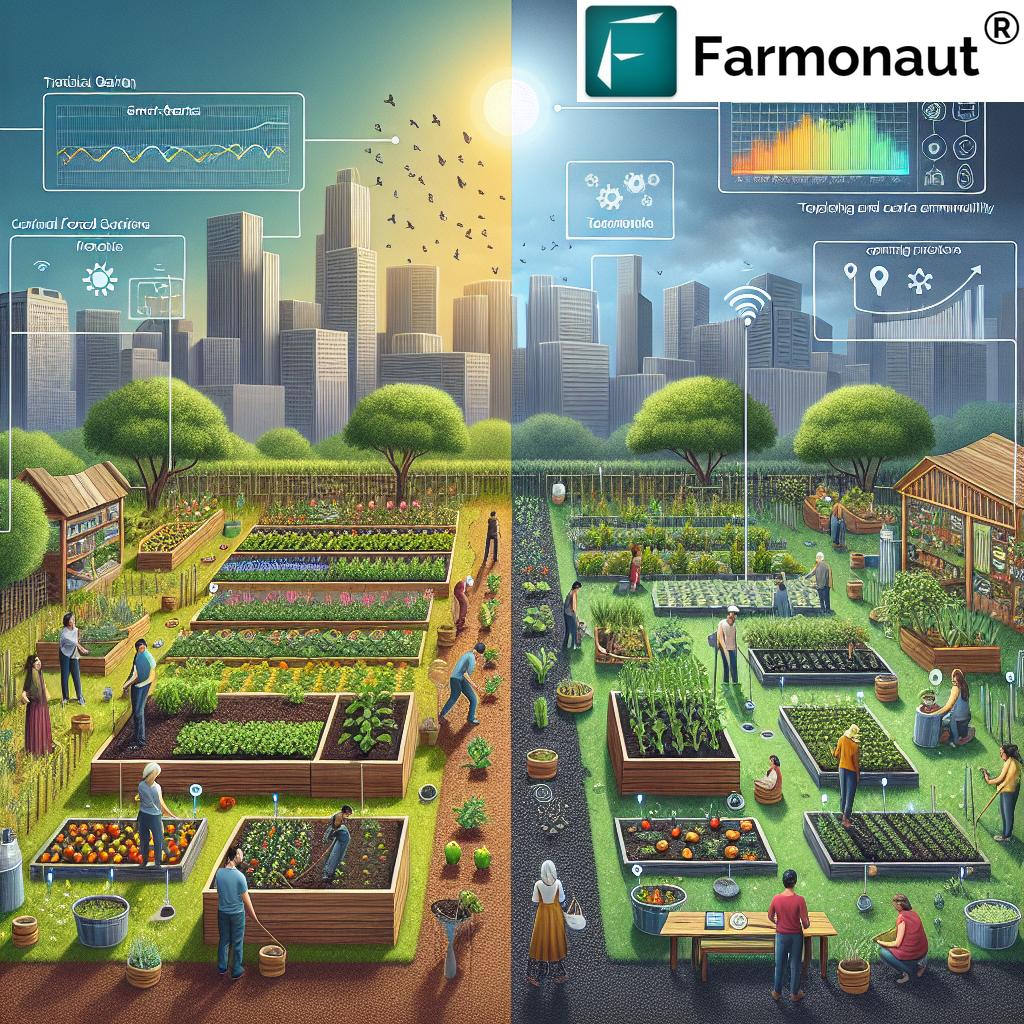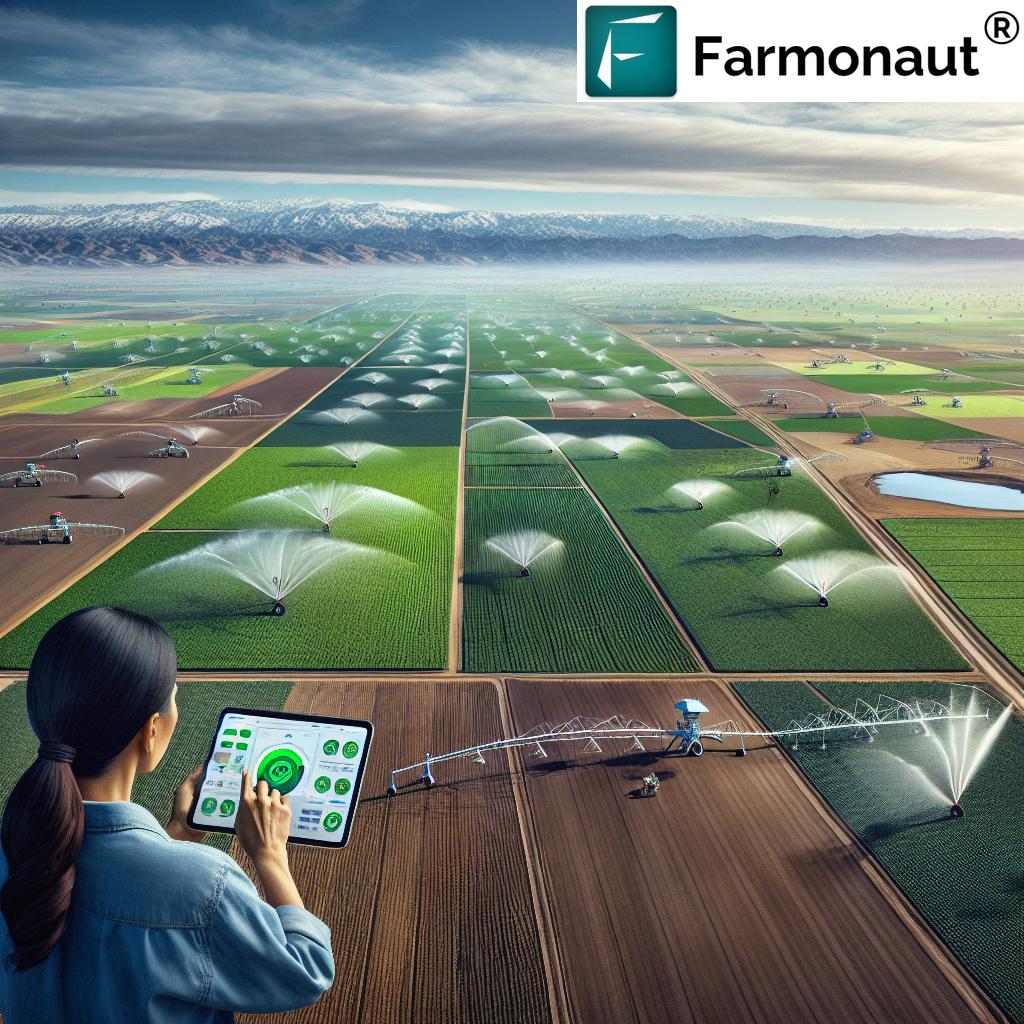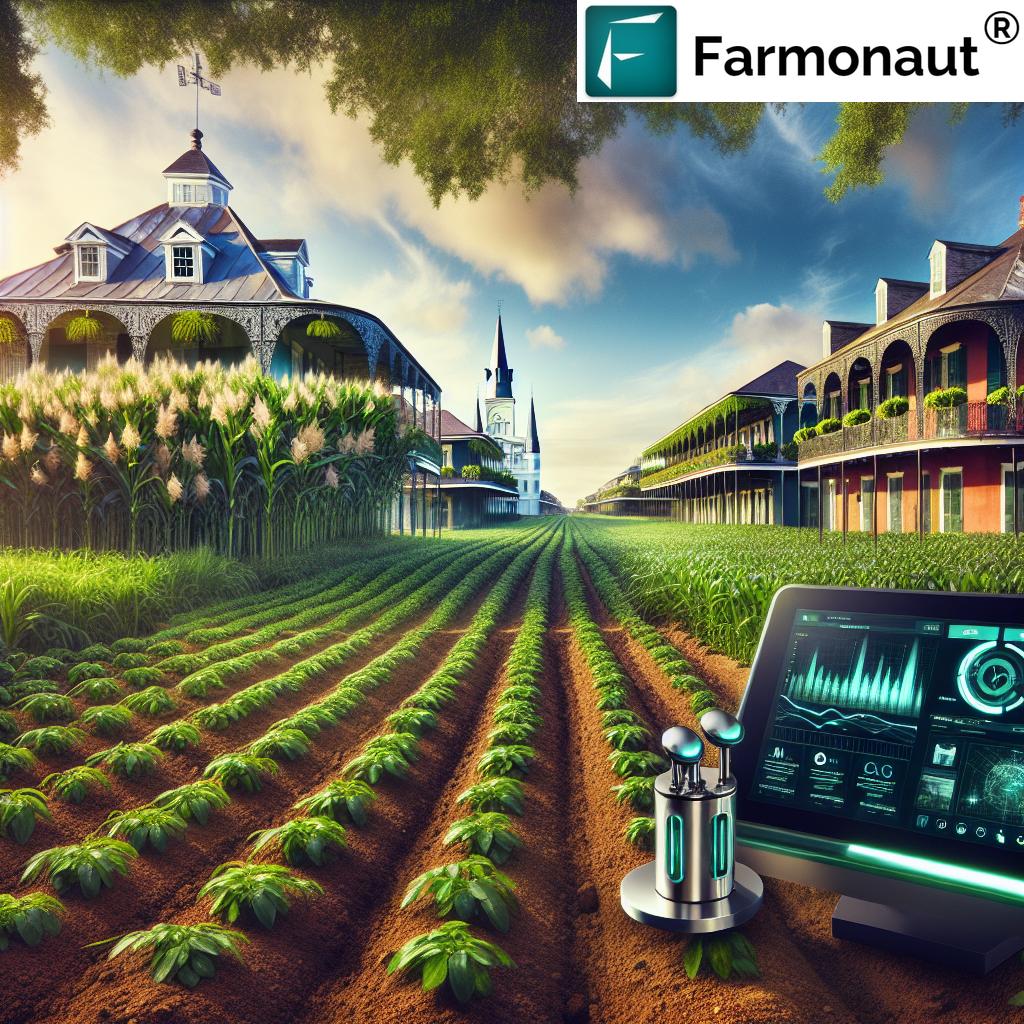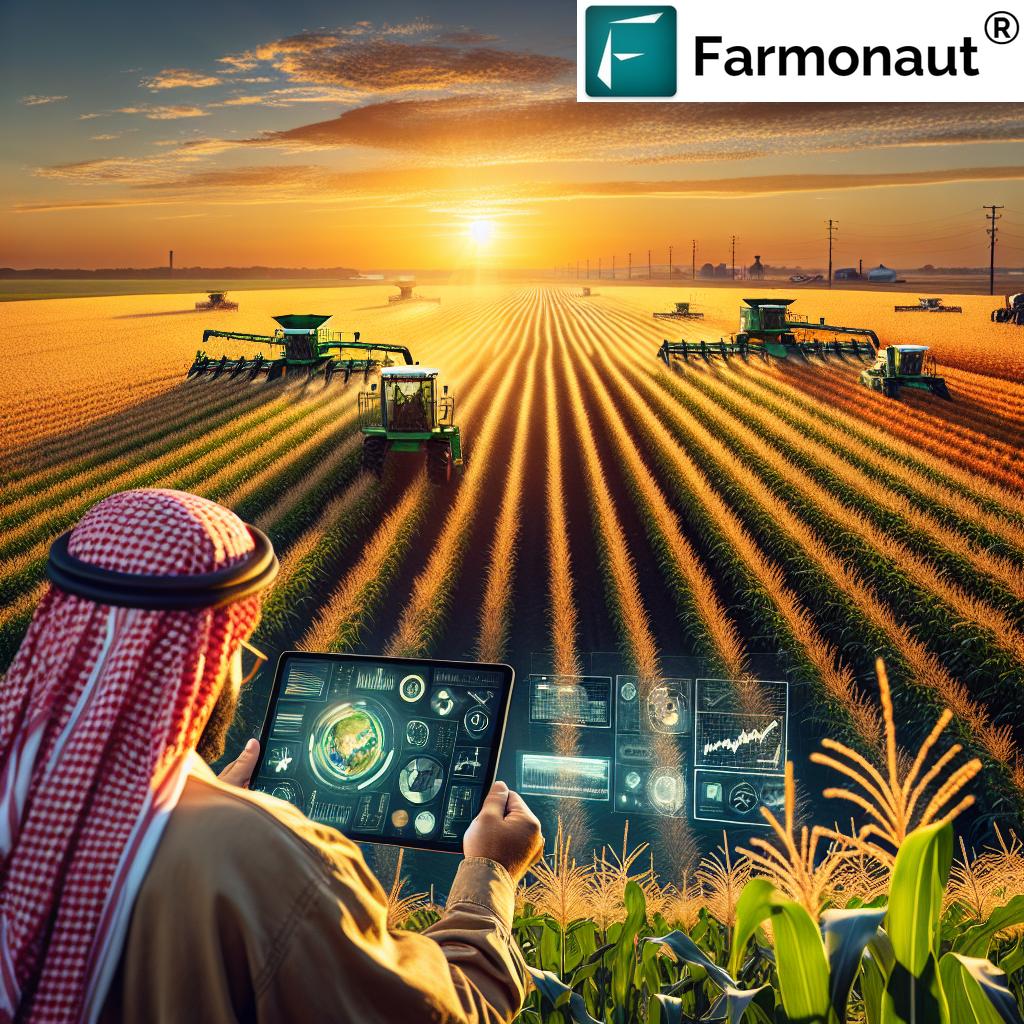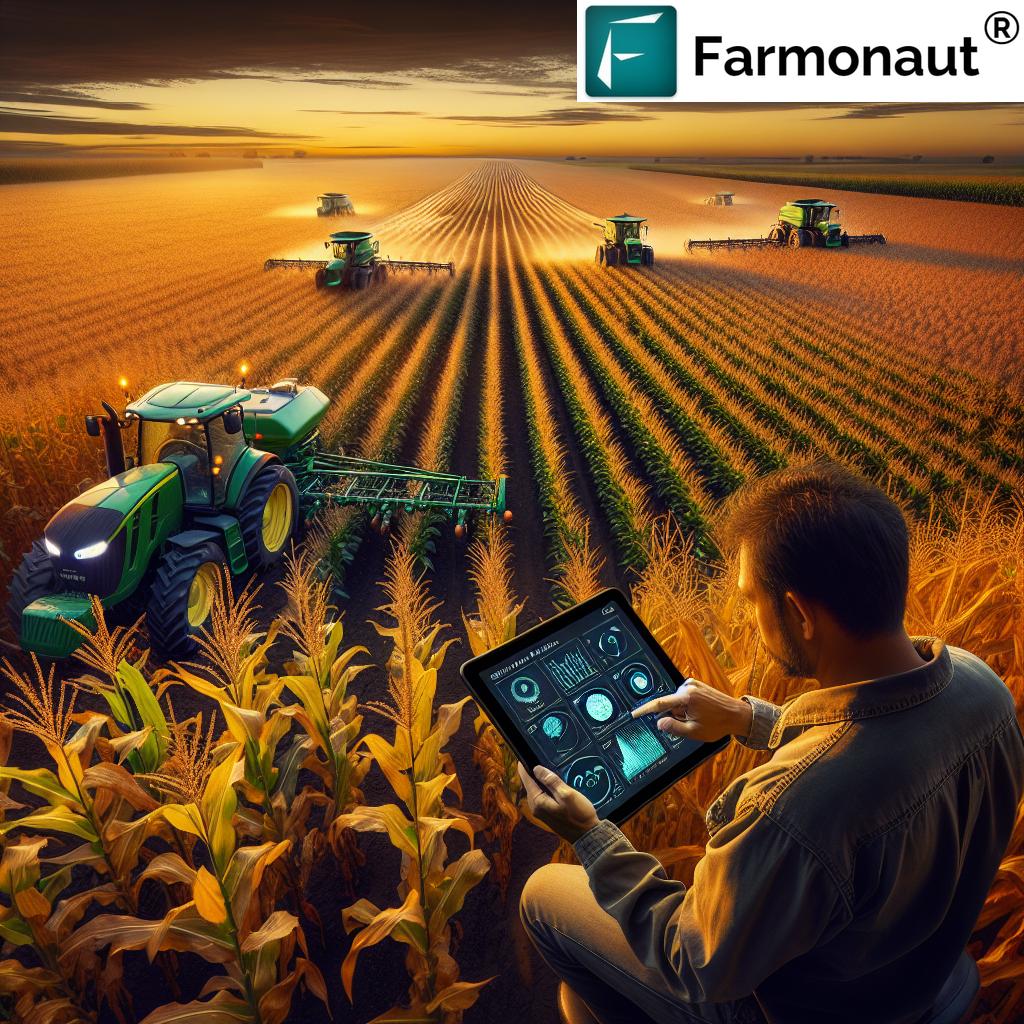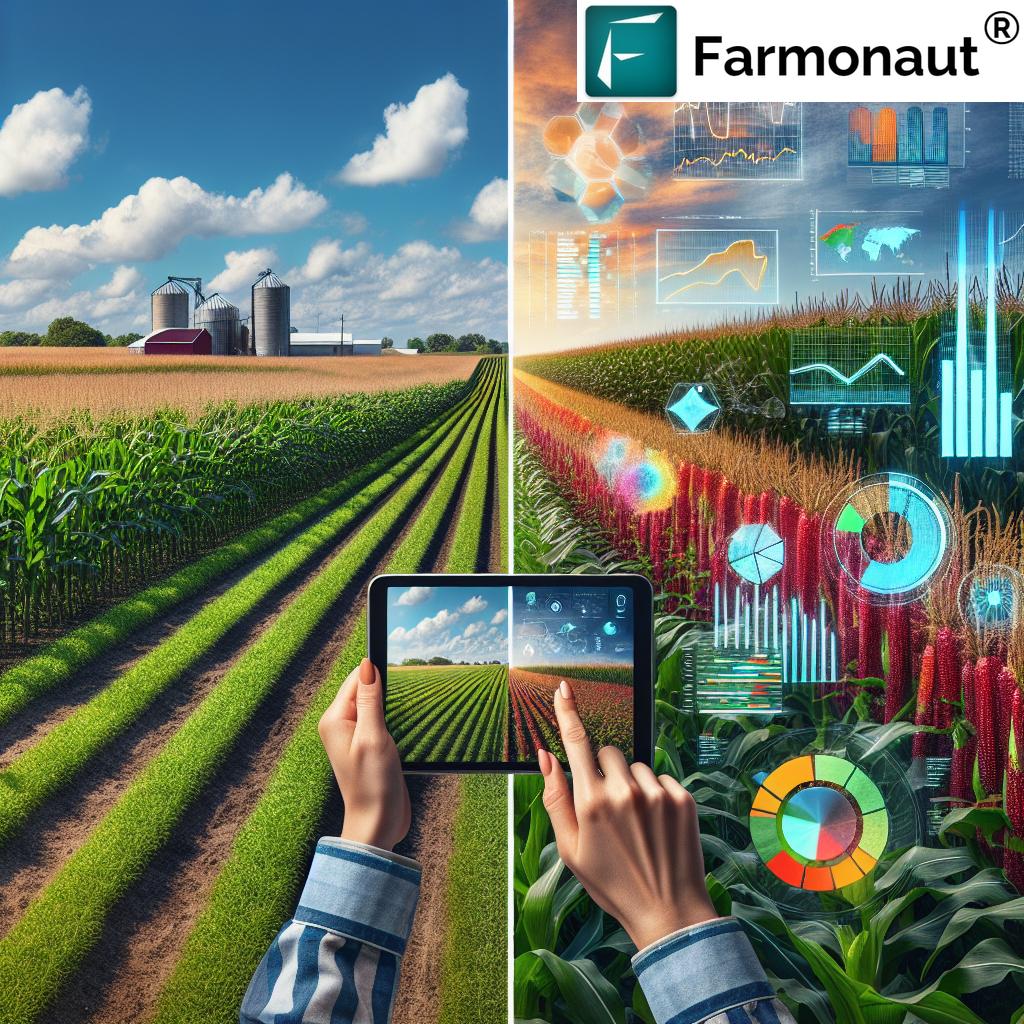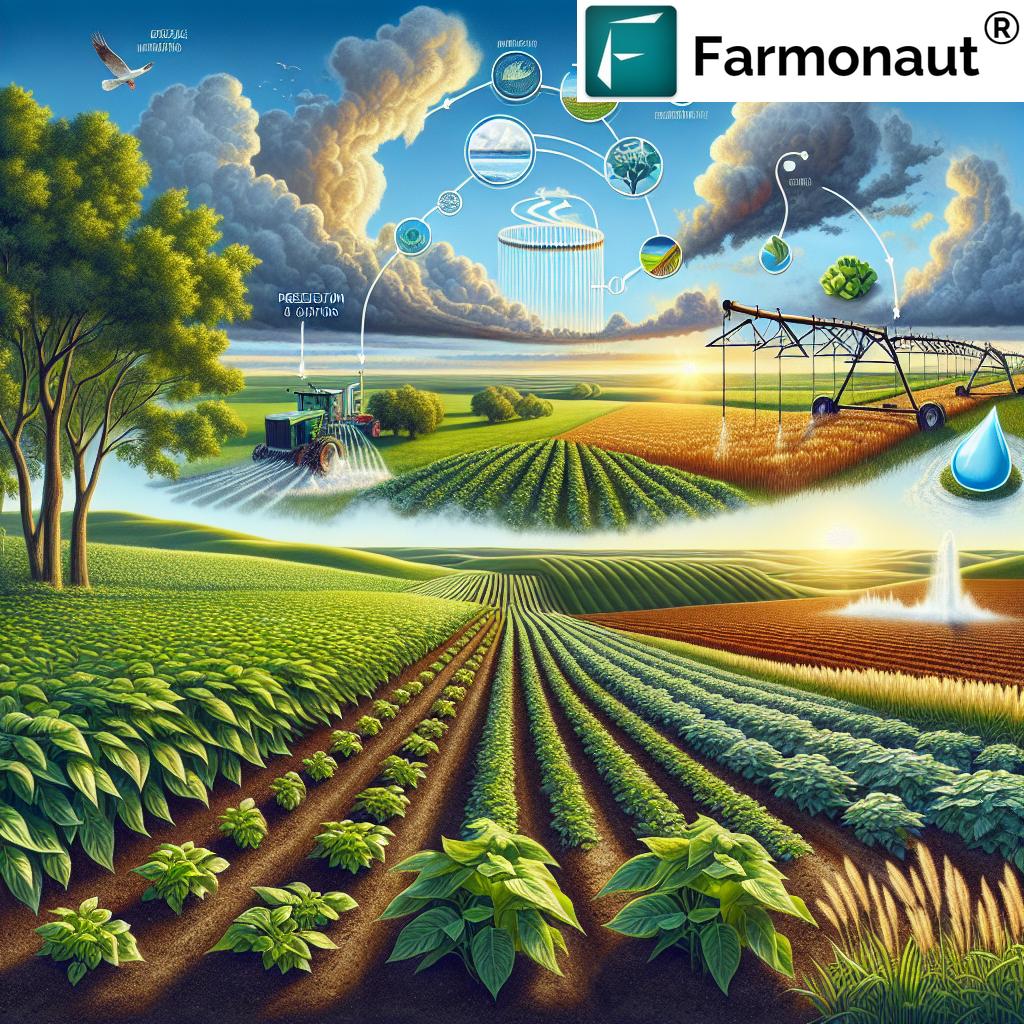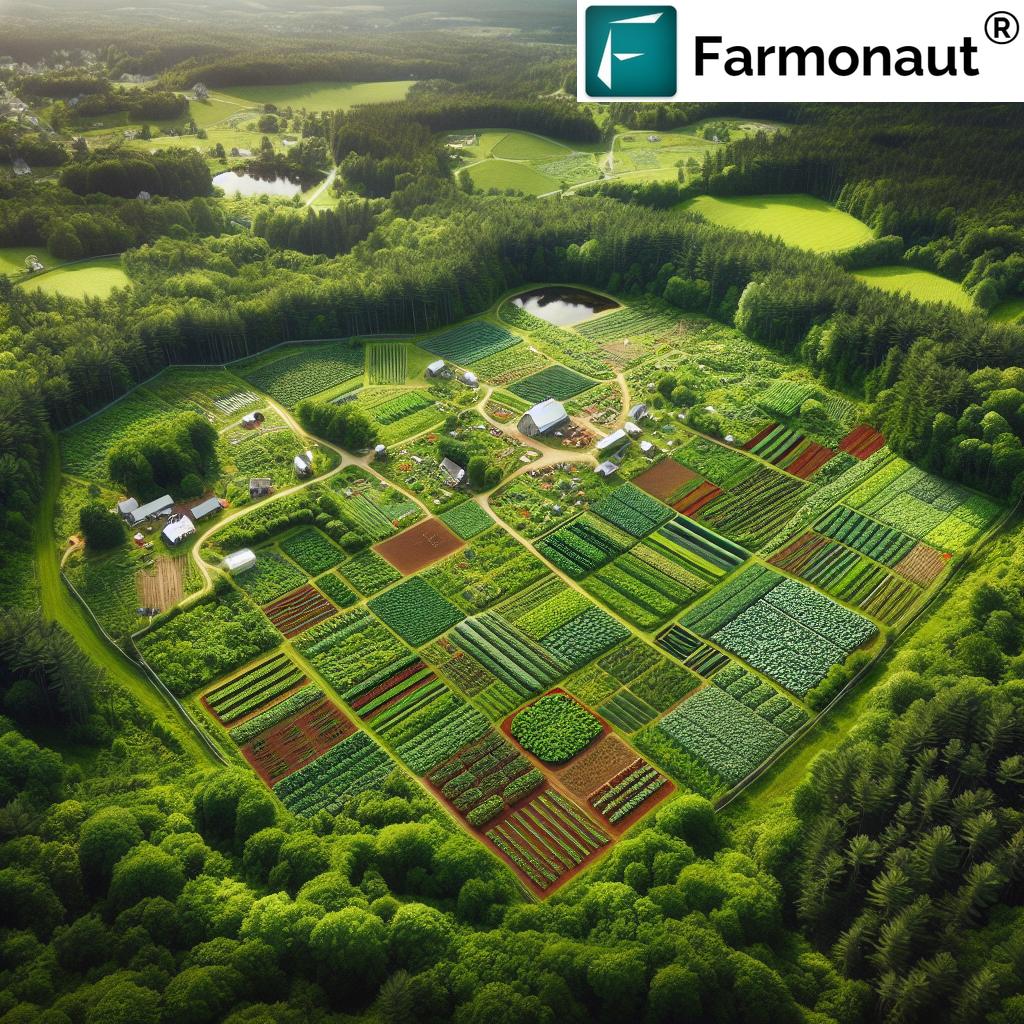Sustainable Urban Agriculture: How Farmonaut Revolutionizes Community Gardening and Food Security in the United States
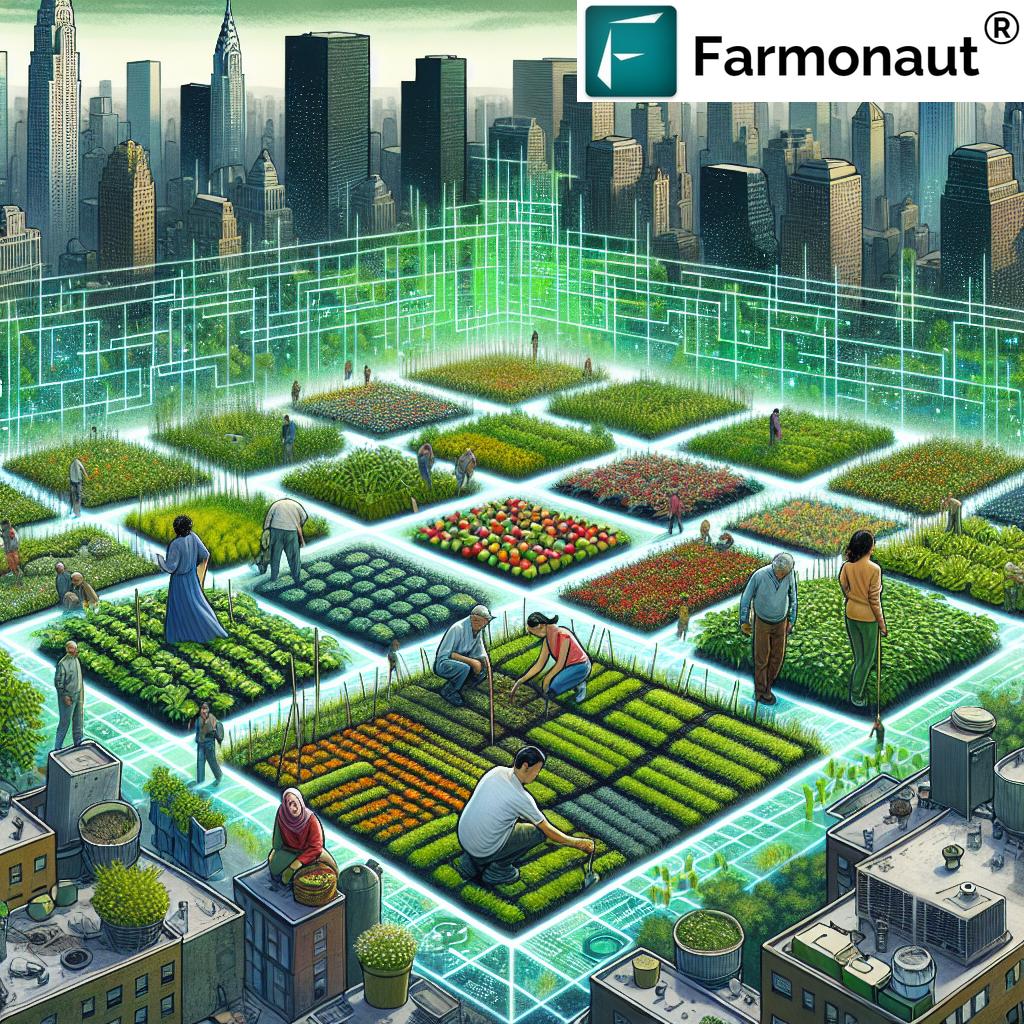
“The “People’s Garden” initiative spans nationwide, promoting food security and resilient production across the United States.”
In recent years, we’ve witnessed a remarkable transformation in the way we think about food production and community engagement in the United States. The rise of sustainable urban agriculture and the expansion of community gardening benefits have revolutionized local food systems across the nation. At the forefront of this green revolution is the innovative “People’s Garden” initiative, a nationwide effort that’s reshaping our approach to food security solutions and resilient food production.
In this comprehensive guide, we’ll explore how urban farming techniques and sustainable gardening practices are creating community-driven agriculture projects that benefit both people and wildlife. We’ll delve into the criteria for joining this movement, including the use of GIS mapping and conservation data to support agricultural education resources. From small container gardens to expansive urban farms, we’ll uncover how this initiative is addressing food security challenges in diverse ways.
Join us as we discover how these gardens serve as living laboratories for sustainable practices, promoting soil health, water conservation, and pollinator protection. We’ll also explore how this program is fostering community engagement, improving nutrition, and building more resilient local food systems. Get ready to dive into the world of urban agriculture and learn how you can contribute to a more sustainable future!
The Rise of Sustainable Urban Agriculture in the United States
Urban agriculture has experienced a significant resurgence in recent years, transforming cityscapes and community spaces across the United States. This movement goes beyond simply growing food in urban environments; it represents a shift towards more sustainable, localized food systems that address a range of social, economic, and environmental challenges.
- Food Security: Urban agriculture plays a crucial role in improving access to fresh, nutritious produce in food deserts.
- Community Building: Gardens and urban farms serve as gathering spaces, fostering social connections and community pride.
- Environmental Benefits: Green spaces in cities help mitigate the urban heat island effect and improve air quality.
- Education: Urban agriculture projects provide hands-on learning opportunities about food production and nutrition.
The integration of technology, such as Farmonaut’s satellite-based farm management solutions, has further revolutionized urban agriculture. By providing real-time crop health monitoring and AI-based advisory systems, Farmonaut empowers urban farmers to make data-driven decisions, optimizing their yields and resource management.
The People’s Garden Initiative: A Nationwide Movement
The People’s Garden initiative is a groundbreaking program that’s transforming communities across the United States. Launched with the goal of promoting sustainable agriculture and food security, this initiative has quickly grown into a nationwide movement that’s reshaping our relationship with food and the environment.
Key Objectives of the People’s Garden Initiative:
- Promote sustainable agriculture practices
- Increase access to fresh, locally-grown produce
- Educate communities about nutrition and food production
- Create green spaces that benefit both people and wildlife
- Foster community engagement and social connections
One of the most exciting aspects of the People’s Garden initiative is its inclusivity. Gardens of all sizes and types are welcome, from small container gardens on urban balconies to expansive community plots in rural areas. This diversity allows for a wide range of approaches to address food security challenges and promote sustainable agriculture practices.
Criteria for Joining the People’s Garden Movement
To become part of the People’s Garden initiative, gardens must meet specific criteria that align with the program’s goals of sustainability, community engagement, and education. These criteria ensure that participating gardens contribute meaningfully to their communities and the environment.
Essential Criteria for People’s Gardens:
- Benefit the Community: Gardens must provide tangible benefits to the local community, such as increased access to fresh produce or educational opportunities.
- Collaborative Effort: The garden should be a result of community collaboration, involving local organizations, schools, or neighborhood groups.
- Sustainable Practices: Gardens must incorporate sustainable techniques, such as water conservation, composting, and organic pest management.
- Educational Component: There should be an educational aspect to the garden, offering opportunities for learning about agriculture, nutrition, and environmental stewardship.
- Public Access: Gardens should be accessible to the public, either through open hours or community events.
Farmonaut’s technology can play a crucial role in helping gardens meet these criteria. For instance, the platform’s satellite-based crop health monitoring can assist gardeners in implementing sustainable practices, while its AI advisory system can provide educational resources to community members.
Explore Farmonaut’s API for advanced agricultural insights
The Role of GIS Mapping and Conservation Data
Geographic Information System (GIS) mapping and conservation data play a crucial role in the success of the People’s Garden initiative and urban agriculture projects across the United States. These tools provide valuable insights that help gardeners and urban farmers make informed decisions about land use, resource management, and conservation efforts.
Benefits of GIS Mapping in Urban Agriculture:
- Site Selection: GIS tools help identify suitable locations for new gardens based on factors like soil quality, sunlight exposure, and proximity to water sources.
- Resource Management: Mapping irrigation systems and soil types allows for more efficient water and nutrient management.
- Urban Planning: GIS data helps integrate urban agriculture into broader city planning efforts, ensuring gardens complement other land uses.
- Biodiversity Monitoring: Conservation data can track the impact of urban gardens on local wildlife and pollinator populations.
Farmonaut’s satellite-based technology complements GIS mapping efforts by providing real-time data on crop health and environmental conditions. This integration of technologies allows for more precise and sustainable urban agriculture practices.
Access Farmonaut’s API Developer Docs for in-depth integration guidance
From Container Gardens to Urban Farms: Diverse Approaches to Food Security
The People’s Garden initiative embraces a wide range of gardening approaches, recognizing that different communities have varying needs and resources. This diversity is key to addressing food security challenges across urban, suburban, and rural areas of the United States.
Types of Gardens in the Initiative:
- Container Gardens: Ideal for urban dwellers with limited space, these gardens use pots, planters, or even recycled containers to grow vegetables and herbs.
- Rooftop Gardens: Utilizing unused urban spaces, rooftop gardens can significantly increase a city’s green space and food production capacity.
- Community Allotments: These shared spaces allow multiple individuals or families to cultivate their own plots within a larger garden area.
- School Gardens: Educational gardens in schools provide hands-on learning experiences and fresh produce for school meals.
- Urban Farms: Larger-scale operations that can include a mix of vegetables, fruits, and even small livestock, often supplying local markets and restaurants.
Each of these garden types contributes uniquely to food security and community engagement. For instance, container gardens can provide fresh herbs and vegetables to apartment dwellers, while urban farms can significantly impact a neighborhood’s access to fresh produce.
“Urban agriculture projects range from small container gardens to expansive farms, addressing diverse food security challenges in communities.”
Living Laboratories: Sustainable Practices in Action
People’s Gardens serve as living laboratories, showcasing and testing a wide range of sustainable gardening practices. These gardens not only produce food but also demonstrate how urban agriculture can contribute to environmental conservation and ecosystem health.
Key Sustainable Practices in People’s Gardens:
- Soil Health Management: Implementing composting, cover cropping, and minimal tillage to maintain soil fertility and structure.
- Water Conservation: Using efficient irrigation systems, rainwater harvesting, and drought-resistant plant varieties to minimize water usage.
- Pollinator Protection: Creating habitats for bees, butterflies, and other pollinators through diverse plantings and avoiding harmful pesticides.
- Integrated Pest Management: Utilizing natural predators, companion planting, and other non-chemical methods to control pests.
- Biodiversity Promotion: Growing a diverse range of crops and incorporating native plants to support local ecosystems.
Farmonaut’s technology can significantly enhance these sustainable practices. For example, its satellite-based crop health monitoring can help gardeners identify water stress or nutrient deficiencies early, allowing for more targeted and efficient resource use.
Community Engagement and Social Impact
One of the most significant aspects of the People’s Garden initiative is its focus on community engagement and social impact. These gardens do more than just grow food; they cultivate connections, build social capital, and empower communities to take control of their food systems.
Ways People’s Gardens Foster Community Engagement:
- Volunteer Opportunities: Gardens provide spaces for community members to volunteer, learn new skills, and contribute to local food production.
- Educational Workshops: Many gardens offer workshops on gardening, nutrition, and sustainable living, spreading knowledge throughout the community.
- Community Events: Harvest festivals, garden workdays, and other events bring people together, strengthening community bonds.
- Intergenerational Learning: Gardens often facilitate knowledge sharing between older and younger generations, preserving traditional gardening wisdom.
- Cultural Exchange: In diverse communities, gardens can become spaces for cultural exchange through the growing and sharing of culturally significant crops.
Farmonaut’s platform can enhance community engagement by providing easy-to-understand data visualizations and insights that can be shared during workshops or community events, making the science of agriculture more accessible to all.
Improving Nutrition and Building Resilient Food Systems
The People’s Garden initiative plays a crucial role in improving nutrition and building more resilient local food systems across the United States. By bringing fresh, locally-grown produce directly into communities, these gardens address issues of food access and nutrition education.
Impact on Nutrition and Food Systems:
- Increased Access to Fresh Produce: Gardens provide a local source of fresh fruits and vegetables, especially important in areas with limited access to grocery stores.
- Nutrition Education: Hands-on experience in gardens helps people learn about the nutritional value of different foods and how to incorporate them into their diets.
- Dietary Diversity: Community gardens often grow a wide variety of crops, encouraging people to try new foods and diversify their diets.
- Food System Resilience: Local food production reduces dependence on long supply chains, making communities more resilient to disruptions.
- Economic Benefits: Some gardens sell produce at local markets, providing economic opportunities and keeping food dollars within the community.
Farmonaut’s technology can contribute to these efforts by helping gardeners optimize their crop yields and quality, ensuring a steady supply of nutritious produce. The platform’s AI-based advisory system can also provide valuable insights on crop selection and management to maximize nutritional output.
The Role of Technology in Urban Agriculture
As urban agriculture continues to grow and evolve, technology is playing an increasingly important role in maximizing efficiency, sustainability, and productivity. Innovative solutions like those offered by Farmonaut are revolutionizing the way urban farmers approach their work.
Key Technological Advancements in Urban Agriculture:
- Satellite-Based Monitoring: Farmonaut’s satellite imagery technology allows urban farmers to monitor crop health and soil moisture levels in real-time, enabling more precise management of resources.
- AI-Powered Advisory Systems: Advanced AI systems, like Farmonaut’s Jeevn AI, provide personalized recommendations for crop management, helping even novice gardeners achieve better results.
- IoT Sensors: Internet of Things (IoT) devices can monitor various environmental factors, automating tasks like irrigation and ventilation in greenhouse settings.
- Vertical Farming Technologies: Innovations in LED lighting and hydroponic systems are making vertical farming more efficient and viable in urban spaces.
- Data Analytics: Platforms that aggregate and analyze data from various sources help urban farmers make more informed decisions about planting, harvesting, and resource allocation.
By leveraging these technologies, urban agriculture projects can significantly increase their productivity and sustainability. Farmonaut’s suite of tools, including satellite monitoring and AI advisory systems, are particularly well-suited to the unique challenges of urban farming environments.
The Impact of Urban Agriculture Initiatives in U.S. Cities
To better understand the tangible effects of urban agriculture initiatives like the People’s Garden across the United States, let’s examine some key metrics in major cities:
| City | Number of Community Gardens | Annual Food Production (lbs) | Food Insecurity Reduction (%) | Green Space Increase (acres) | Community Engagement (participants/year) |
|---|---|---|---|---|---|
| New York City | 550 | 87,000 | 2.5% | 100 | 25,000 |
| Chicago | 800 | 120,000 | 3.2% | 150 | 30,000 |
| Los Angeles | 400 | 65,000 | 1.8% | 75 | 20,000 |
| Detroit | 1,500 | 200,000 | 5.0% | 200 | 40,000 |
| Seattle | 90 | 30,000 | 1.5% | 25 | 10,000 |
This data illustrates the significant impact that urban agriculture initiatives are having across diverse U.S. cities. From food production to community engagement, these programs are making a real difference in addressing food security and sustainability challenges.
Challenges and Future Directions
While urban agriculture and initiatives like the People’s Garden have made significant strides, they also face several challenges. Addressing these issues will be crucial for the continued growth and success of sustainable urban agriculture in the United States.
Key Challenges:
- Land Access: Finding suitable and affordable land in urban areas can be difficult, especially in densely populated cities.
- Soil Contamination: Urban soils may contain pollutants, requiring careful testing and remediation.
- Water Access and Management: Ensuring adequate and sustainable water sources for urban gardens can be challenging in some areas.
- Policy and Zoning: Some cities have zoning laws that restrict urban agriculture activities, necessitating policy changes.
- Long-term Sustainability: Maintaining consistent funding and community engagement over time can be challenging for some projects.
Future Directions:
- Integration with Smart City Initiatives: Incorporating urban agriculture into broader smart city planning can create more sustainable urban ecosystems.
- Expansion of Vertical Farming: As technology improves, vertical farming could become more prevalent in urban areas, maximizing space efficiency.
- Increased Use of Data and AI: Platforms like Farmonaut will likely play an even bigger role in optimizing urban agriculture practices.
- Climate Resilience: Urban agriculture will increasingly be seen as a tool for building climate-resilient cities, with gardens designed to mitigate urban heat islands and manage stormwater.
- Policy Development: We can expect to see more cities developing comprehensive urban agriculture policies to support and regulate these initiatives.
As we look to the future, the role of technology in addressing these challenges and driving innovation in urban agriculture cannot be overstated. Farmonaut’s suite of tools, from satellite monitoring to AI-powered advisories, will be instrumental in helping urban farmers overcome obstacles and maximize the potential of their gardens.
Conclusion: Cultivating a Sustainable Future
The People’s Garden initiative and the broader movement of sustainable urban agriculture are transforming communities across the United States. By bringing food production into urban spaces, these projects are not only addressing food security challenges but also fostering community engagement, promoting environmental sustainability, and building more resilient local food systems.
As we’ve explored throughout this article, the success of these initiatives relies on a combination of community effort, sustainable practices, and innovative technologies. Platforms like Farmonaut play a crucial role in this ecosystem, providing urban farmers with the tools and insights they need to maximize their productivity and sustainability.
Looking ahead, the future of urban agriculture in the United States is bright. As cities continue to grow and evolve, integrating food production into urban landscapes will become increasingly important. By embracing sustainable practices, leveraging technology, and fostering community involvement, we can create a more food-secure and environmentally sustainable future for all.
Whether you’re a seasoned gardener, a community organizer, or simply someone interested in where your food comes from, there’s a place for you in this growing movement. We encourage you to explore the People’s Garden initiative in your area, or consider starting your own urban agriculture project. Together, we can cultivate not just food, but stronger, more resilient communities across the nation.
FAQ Section
Q: What is the People’s Garden initiative?
A: The People’s Garden initiative is a nationwide program in the United States that promotes sustainable agriculture, food security, and community engagement through the creation of gardens in urban, suburban, and rural areas.
Q: How can I join the People’s Garden movement?
A: To join, your garden should benefit the community, be a collaborative effort, use sustainable practices, include an educational component, and be accessible to the public. Check with your local agricultural extension office for specific guidelines in your area.
Q: What types of gardens are included in the initiative?
A: The initiative includes a wide range of gardens, from small container gardens on urban balconies to large community plots and urban farms. School gardens, rooftop gardens, and community allotments are also part of the program.
Q: How does urban agriculture contribute to food security?
A: Urban agriculture increases access to fresh, locally-grown produce, especially in areas with limited access to grocery stores. It also educates communities about nutrition and sustainable food production, contributing to long-term food security.
Q: What role does technology play in urban agriculture?
A: Technology, such as Farmonaut’s satellite-based monitoring and AI advisory systems, helps urban farmers optimize crop yields, manage resources efficiently, and make data-driven decisions. This leads to more productive and sustainable urban agriculture practices.
